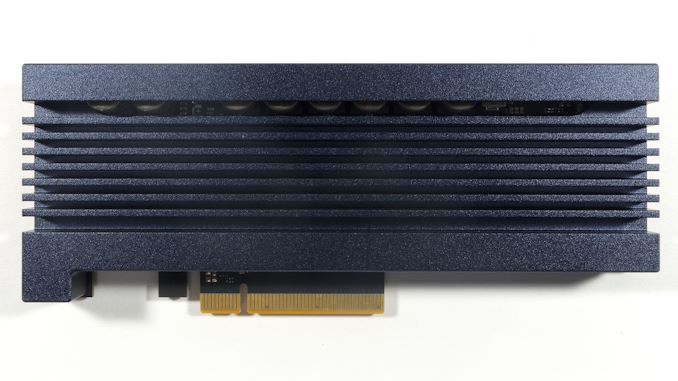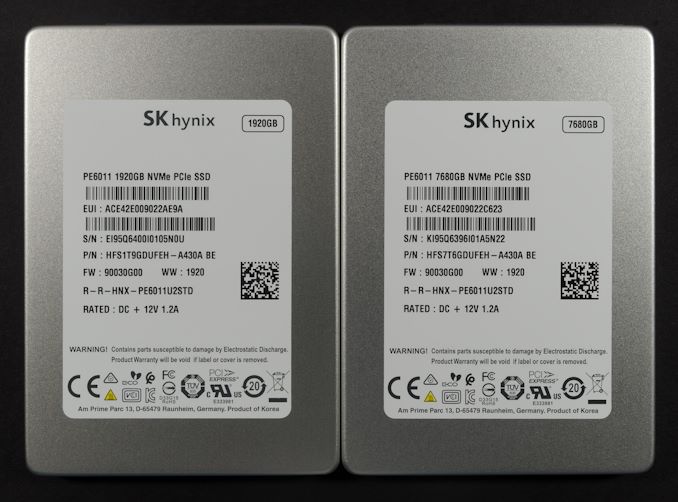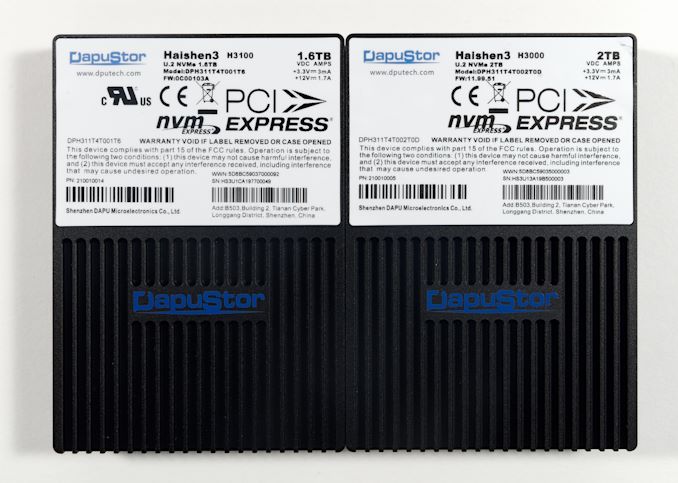Enterprise NVMe Round-Up 2: SK Hynix, Samsung, DapuStor and DERA
by Billy Tallis on February 14, 2020 11:15 AM EST
Last fall, several enterprise SSD vendors reached out to us around the same time, offering review samples of their latest and greatest. We put together an updated test suite for enterprise and datacenter SSDs and spent more than a month hammering the drives. Our review of two SATA drives was published first, but this review of 9 NVMe drives is what we've really been looking forward to. These multi-TB drives show just how far NVMe can go beyond the limits of SATA and SAS SSDs.
Two of the products we're looking at today come from familiar manufacturers. Samsung is the dominant player in the SSD market, shipping more drives than the next three companies combined. We have their PM1725a in house: an older flagship model, but still the fastest we've ever tested with almost twice the random read performance of an Intel Optane SSD. SK Hynix sent over their PE6011, a low-power entry-level datacenter U.2 drive that is part of their strategy to reestablish a foothold in market segments where they have faltered in recent years.
We also have two new brands featured in one of our reviews for the first time. DapuStor and DERA are two Chinese drive manufacturers that have been around for a few years but have until recently been focusing on their domestic market. DERA's strategy is more centered around developing home-grown technology to compete with foreign suppliers by designing their own SSD controller. DapuStor worked with familiar names like Marvell and Kioxia/Toshiba to create datacenter SSDs focused on efficiency, while also pursuing a long-term roadmap toward advanced in-house tech.
Nine new drives adding up to 40TB of high-end storage might seem like a lot, but it's barely enough to to cover the breadth of the enterprise SSD market. No two of these models are in direct competition. Enterprise SSD product segments can be defined in terms of form factor, write endurance, capacity and performance. Different use cases will call for a different kind of drive, and there's no one size fits all solution.
| Reviewed Models Overview (Drives Tested in Bold) |
|||||||
| Model | Interface | Form Factor | Capacities | Memory | Write Endurance (DWPD) |
||
| DapuStor Haishen3 H3000 |
PCIe 3.0 x4 | 2.5" 15mm U.2 | 1 TB 2 TB 4 TB 8 TB |
96L 3D TLC | 1 DWPD | ||
| DapuStor Haishen3 H3100 |
PCIe 3.0 x4 | 2.5" 15mm U.2 | 800 GB 1.6 TB 3.2 TB 6.4 TB |
96L 3D TLC | 3 DWPD | ||
| DERA D5437 |
PCIe 3.0 x4 | 2.5" 15mm U.2 | 2 TB 4 TB 8 TB |
64L 3D TLC | 1 DWPD | ||
| DERA D5457 |
PCIe 3.0 x4 | 2.5" 15mm U.2 | 1.6 TB 3.2 TB 6.4 TB |
64L 3D TLC | 3 DWPD | ||
| SK Hynix PE6011 |
PCIe 3.0 x4 | 2.5" 7mm U.2 | 960 GB 1.92 TB 3.84 TB 7.68 TB |
72L 3D TLC | 1 DWPD | ||
| Samsung PM1725a |
PCIe 3.0 x8 | HHHL AIC | 1.6 TB 3.2 TB 6.4 TB |
48L 3D TLC | 5 DWPD | ||
| Previously Reviewed by AnandTech: | |||||||
| Micron 5100 MAX |
SATA | 2.5" 7mm | 240 GB 480 GB 960 GB 1.92 TB |
32L 3D TLC | 5 DWPD | ||
| Samsung 883 DCT |
SATA | 2.5" 7mm | 240 GB 480 GB 960 GB 1.92 TB 3.84 TB |
64L 3D TLC | 0.8 DWPD | ||
| Samsung 983 DCT |
PCIe 3.0 x4 | 2.5" 7mm U.2 | 960 GB 1.92 TB |
64L 3D TLC | 0.8 DWPD | ||
| Intel DC P4510 |
PCIe 3.0 x4 | 2.5" 15mm U.2 | 1 TB 2 TB 4 TB 8 TB |
64L 3D TLC | 0.7–1.1 DWPD | ||
| Intel Optane DC P4800X |
PCIe 3.0 x4 | HHHL AIC | 375 GB 750 GB 1.5 TB |
3D XPoint | 60 DWPD | ||
| Memblaze PBlaze5 C916 |
PCIe 3.0 x8 | HHHL AIC | 3.2 TB 6.4 TB |
64L 3D TLC | 3 DWPD | ||
| Note: Tested capacities are shown in bold | |||||||
To provide some more meaningful comparisons, we've retested and included several other enterprise SSDs from previous reviews.














33 Comments
View All Comments
PaulHoule - Friday, February 14, 2020 - link
"The Samsung PM1725a is strictly speaking outdated, having been succeeded by a PM1725b with newer 3D NAND and a PM1735 with PCIe 4.0. But it's still a flagship model from the top SSD manufacturer, and we don't get to test those very often."Why? If you've got so much ink for DRAMless and other attempts to produce a drive with HDD costs and SSD performance (hopefully warning people away?) why can't you find some for flagship products from major manufacturers?
Billy Tallis - Friday, February 14, 2020 - link
The division of Samsung that manages the PM17xx products doesn't really do PR. We only got this drive to play with because MyDigitalDiscount wanted an independent review of the drive they're selling a few thousand of.The Samsung 983 DCT is managed by a different division than the PM983, and that's why we got to review the 983 DCT, 983 ZET, 883 DCT, and so on. But that division hasn't done a channel/retail version of Samsung's top of the line enterprise drive.
romrunning - Friday, February 14, 2020 - link
Too bad you don't get more samples of the enterprise stuff. I mean, you have both influencers, recommenders, and straight-up buyers of enterprise storage who read Anandtech.Billy Tallis - Friday, February 14, 2020 - link
Some of it is just that I haven't tried very hard to get more enterprise stuff. It worked okay for my schedule to spend 5 weeks straight testing enterprise drives because we didn't have many consumer drives launch over the winter. But during other times of the year, it's tough to justify the time investment of updating a test suite and re-testing a lot of drives. That's part of why this is a 4-vendor roundup instead of 4 separate reviews.Since this new test suite seems to be working out okay so far, I'll probably do a few more enterprise drives over the next few months. Kingston already sent me a server boot drive after CES, without even asking me. Kioxia has expressed interest in sampling me some stuff. A few vendors have said they expect to have XL-NAND drives real soon, so I need to hit up Samsung for some Z-NAND drives to retest and hopefully keep this time.
And I'll probably run some of these drives through the consumer test suite for kicks, and upload the results to Bench like I did for one of the PBlaze5s and some of the Samsung DCTs.
PandaBear - Friday, February 14, 2020 - link
ESSD firmware engineer here (and yes I have worked in one of the company above). Enterprise business are mostly selling to large system builder so Anandtech is not really "influence" or "recommend" for enterprise business. There are way more requirements than just 99.99 latency and throughput, and buyers tend to focus on the worst case scenarios than the peak best cases. Oh, pricing matters a lot. You need to be cheap enough to make it to the top 3-4 or else you lose a lot of businesses, even if you are qualified.RobJoy - Tuesday, February 18, 2020 - link
Well these are Intel owners here.Anything PCIe 4.0 has not even crossed their minds, and are patiently waiting for Intel to move their ass.
No chance in hell they dare going AMD Rome way even if it performs better and costs less.
romrunning - Friday, February 14, 2020 - link
This article makes my love of the P4800X even stronger! :) If only they could get the capacity higher and the pricing lower - true of all storage, though especially desired for Optane-based drives.curufinwewins - Friday, February 14, 2020 - link
100% agreed, it's such a paradigm shifter by comparison.eek2121 - Friday, February 14, 2020 - link
Next gen Optane is supposed to significantly raise both capacity and performance. Hopefully Intel is smart and prices their SSD based Optane solutions at a competitive price point.curufinwewins - Friday, February 14, 2020 - link
Ok, great stuff Billy! I know it wasn't really the focus of this review, but dang, I actually came out ludicrously impressed with how very small quantities of first gen optane on relatively low channel installments have such a radically different (and almost always in a good way) behavior to flash. Definitely looking forward to the next generation of this product.